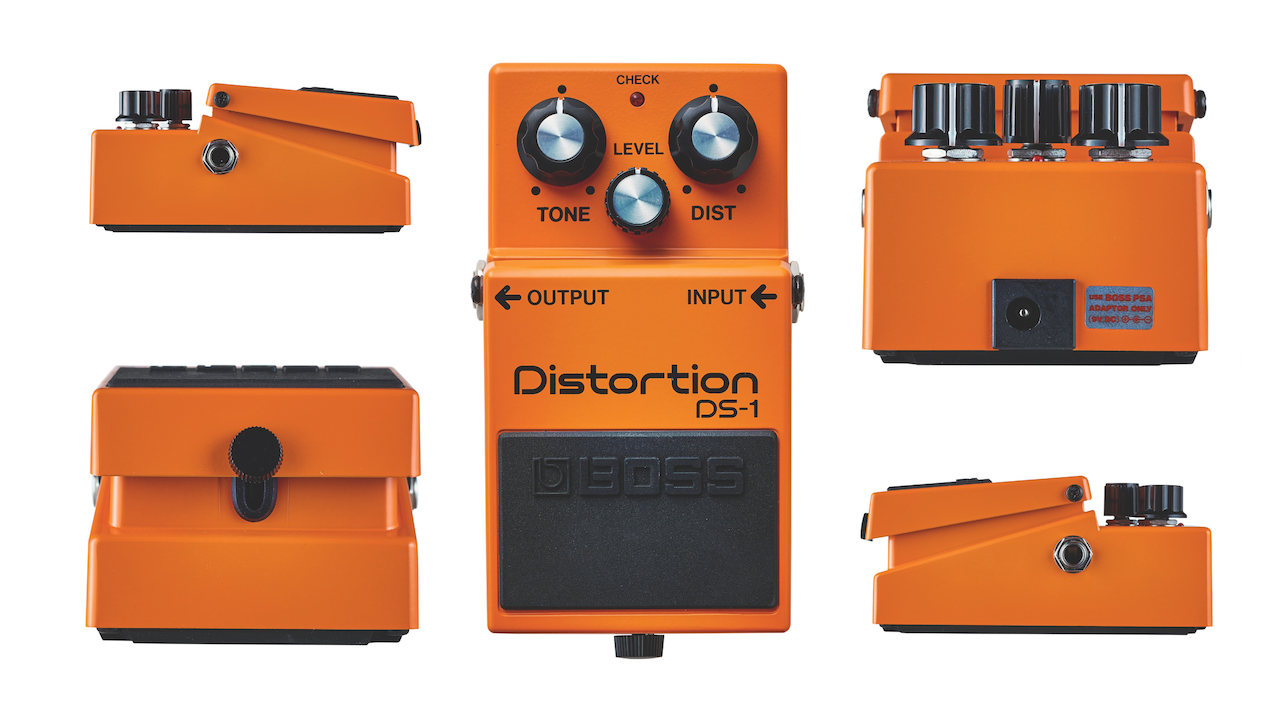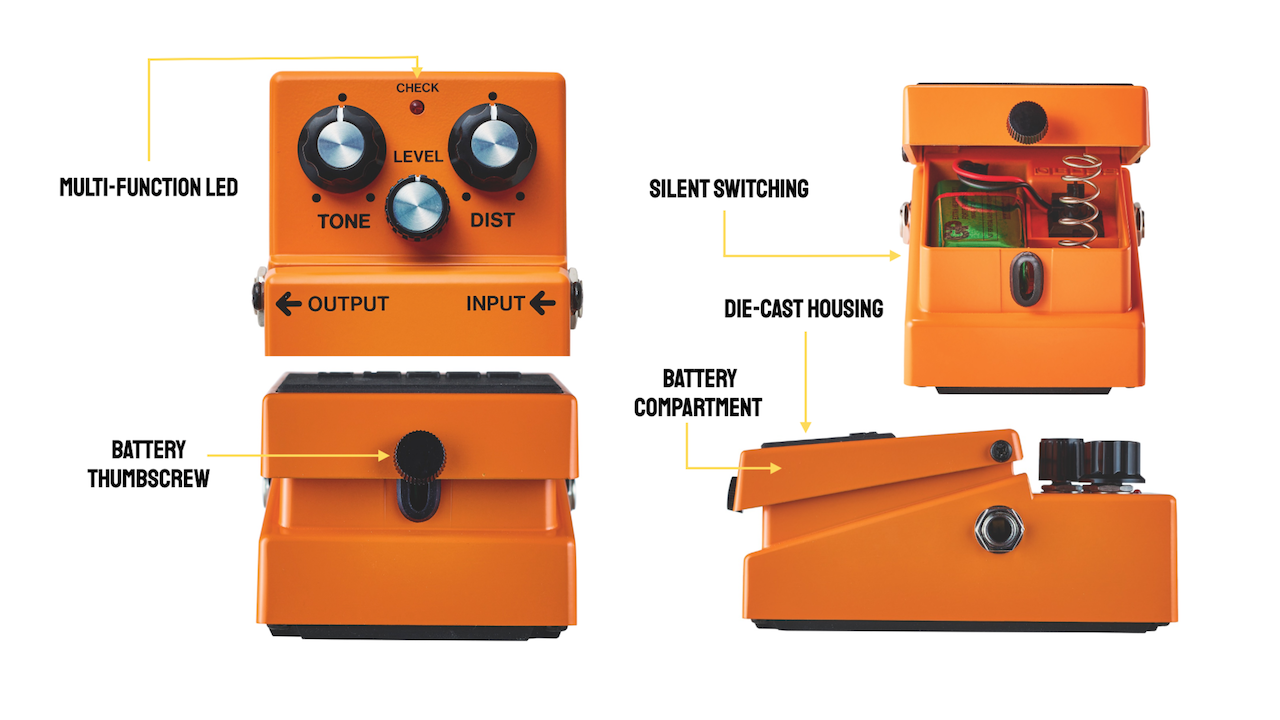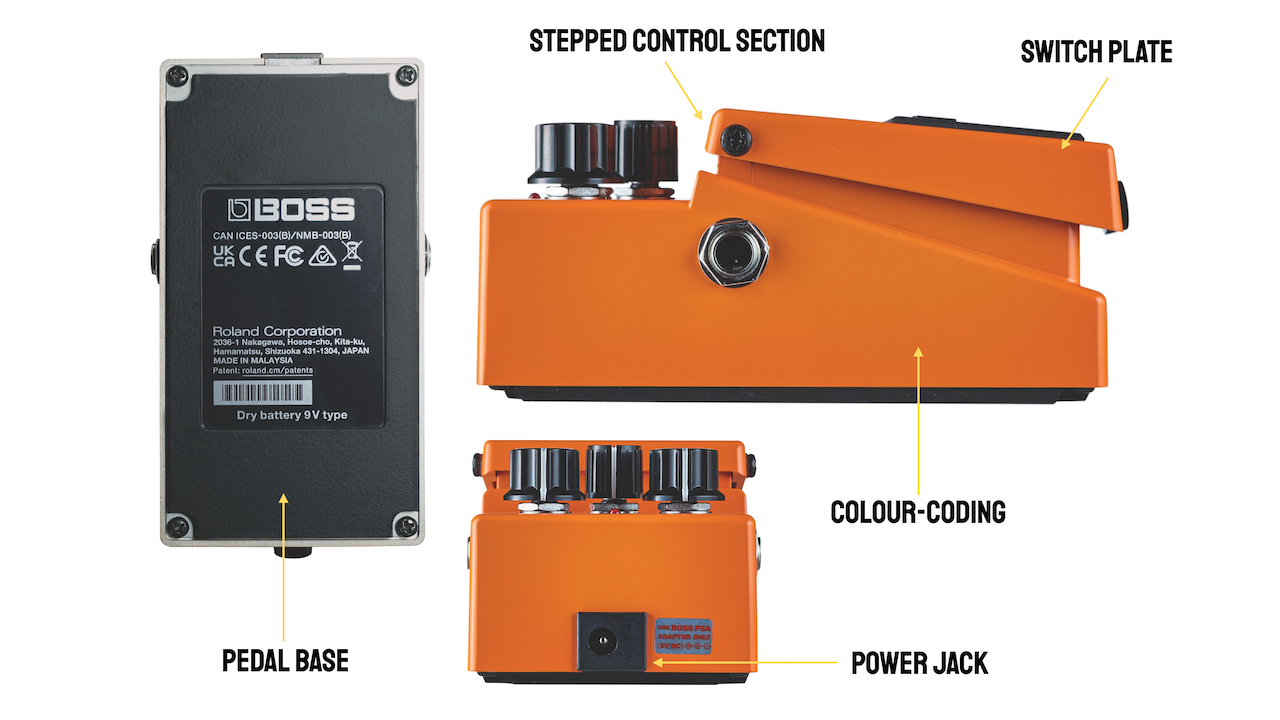
When BOSS introduced its first compact pedals in 1977 – that’s the OD-1 Over Drive, PH-1 Phaser and SP-1 Spectrum, fact fans – it revolutionized the stompbox industry.
Their vivid colors, uniform designs and player-friendly innovations quickly won guitarists over, and have remained a constant over BOSS’s four-decade-plus history. More importantly, their influence is still felt on pedalboards today, whether they feature any BOSS pedals or not.
So let’s look a little closer at how BOSS changed the guitar world, and take the magnifying glass to 10 pedal design features that altered the course of stompbox history…

Multi-Function LED
This LED comes on when your BOSS pedal is engaged and indicates that the pedal is on and working. Its other useful function is to let you know when your battery is running low on juice: if your effect is on but the LED doesn’t light up, it’s time to change the battery.
Battery Thumbscrew
Early BOSS pedals featured a slotted version, but the thumbscrew makes quick battery changes a doddle, without the need for any additional tools. Plus, thanks to its hinged cover, you won’t even need to disconnect or remove the pedal from your ’board.
Battery Compartment
What’s clever about a battery compartment? BOSS pedals house the battery away from the circuit board, so in the event of a leak you’re unlikely to ruin your pedal. It’s kept in position by a comfortable fit, reinforced with foam, so you won’t strain the battery clip.
Die-Cast Housing
The iconic BOSS pedal housing has remained a consistent form factor since the OD-1 was introduced in 1977. This die-cast housing is strong enough to withstand being run over – but, being aluminium, remains light enough for you to carry a ’board full of them.
Silent Switching
BOSS was an early adopter of electronic switching, removing the problematic pops and clicks that can be introduced when operating mechanical, latching switches. What’s more, BOSS footswitches undergo a thorough 100,000‑press test using bespoke machinery to ensure they won’t let you down.

Pedal Base
Every BOSS compact pedal features a rubber-coated baseplate. Not only does this element of the design add grip and withstand drag from your cables if you’re using it without a pedalboard, but it can also keep the pedal in position up to a 60-degree angle.
Get The Pick Newsletter
All the latest guitar news, interviews, lessons, reviews, deals and more, direct to your inbox!
Power Jack
Batteries are fine, but what if your PP3 runs out of juice mid-set? BOSS compact pedals removed this problem from the outset with the inclusion of a power supply jack, which – along with the centre-negative pin configuration – is now an industry standard.
Stepped Control Section
Many early stompboxes were put together in flat, flush-profiled boxes. It seems obvious these days, but BOSS’s stepped control section takes the risk out of knocking (or worse, damaging) the pedal’s controls while switching with your feet.
Colour-Coding
All BOSS compact pedals adhere to the same dimensions, along with similar layouts. So, to make it easier to spot which pedal you’re about to stomp on at a glance, BOSS was one of – if not the – first to colour-code its stompers by effects type.
Switch Plate
A further, often-overlooked feature of all BOSS compact pedals is the large switch plate. This minimises the target area on a dark stage, meaning you’ll never fail to engage or bypass the pedal. It’s also covered with non-slip rubber, just to be sure.
This month, Guitarist magazine includes a free supplement dedicated to 50 Years of BOSS. Click here to download it as a digital version or here for a 'digital page-turner' on Issu.

Stuart has been working for guitar publications since 2008, beginning his career as Reviews Editor for Total Guitar before becoming Editor for six years. During this time, he and the team brought the magazine into the modern age with digital editions, a Youtube channel and the Apple chart-bothering Total Guitar Podcast. Stuart has also served as a freelance writer for Guitar World, Guitarist and MusicRadar reviewing hundreds of products spanning everything from acoustic guitars to valve amps, modelers and plugins. When not spouting his opinions on the best new gear, Stuart has been reminded on many occasions that the 'never meet your heroes' rule is entirely wrong, clocking-up interviews with the likes of Eddie Van Halen, Foo Fighters, Green Day and many, many more. If he's not playing the guitar, you'll likely find Stuart behind the kit playing Valerie to newlyweds.
“The original Jordan Boss Tone was probably used by four out of five garage bands in the late ’60s”: Unpacking the gnarly magic of the Jordan Boss Tone – an actual guitar plug-in that delivers Dan Auerbach-approved fuzz
“This is a powerhouse of a stompbox that manages to keep things simple while offering endless inspiration”: Strymon EC-1 Single Head dTape Echo pedal review










